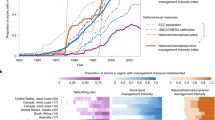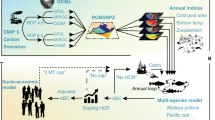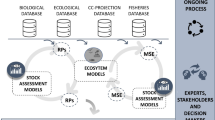Abstract
A recent highly cited paper from this journal develops a model predicting maximum sustainable yield (\(MSY\)) of a fishery using the historical maximum catch (\(MaxCatch\)). The model is parameterized with a small sample of fisheries from the United States, and is subsequently applied globally to estimate the benefits of fishery recovery. That empirical relationship has been adopted for many subsequent high-profile analyses. Unfortunately, the analysis suffers from two important oversights: (1) because the model is non-linear, it suffers from “retransformation bias” and therefore the results significantly understate \(MSY\) and (2) the analysis is parameterized from of a very limited data set and so generalizability of the fitted empirical relationship between \(MSY\) and \(MaxCatch\) to global fisheries is questionable. Here, we rectify both oversights and provide an updated estimate of the relationship between \(MSY\) and \(MaxCatch\).


Similar content being viewed by others
Notes
\(MaxCatch\) is from reported catch statistics and \(MSY\) is estimated from various forms of stock assessments.
This database is constantly being expanded. As more stocks are added, our estimates could be refined.
The new data span \(MaxCatch\) values between 97 and 2 million metric tons, which covers about 70 % of the 20,000 fisheries reporting landings to the FAO and over 90 % of global landings.
References
Branch, T., Hivley, D., & Hilborn, R. (2013). Is the ocean food provision index biased? Nature, 495, E5–E6.
Costello, C., Ovando, D., Hilborn, R., Gaines, S. D., Deschênes, O., & Lester, S. E. (2012). Status and solutions for the world’s unassessed fisheries. Science, 338, 517–520.
Duan, N. (1983). Smearing estimate: A nonparametric retransformation method. Journal of the American Statistical Association, 78, 605–610.
Halpern, B. S., Longo, C., Hardy, D., McLeod, K. L., Samhouri, J. F., Katona, S. K., Kleisner, K., Lester, S. E., O’Leary, J., Ranelletti, M., Rosenberg, A. A., Scarborough, C., Selig, E. R., Best, B. D., Brumbaugh, D. R., Chapin, F. S., Crowder, L. B., Daly, K. L., Doney, S. C., Elfes, C., Fogarty, M. J., Gaines, S. D., Jacobsen, K. I., Karrer, L. B., Leslie, H. M., Neeley, E., Pauly, D., Polasky, S., Ris, B., St Martin, K., Stone, G. S., Sumaila, U. R., Zeller, D. (2012). An index to assess the health and benefits of the global ocean. Nature, 488, 615–620.
Leathwick, J., Moilanen, A., Francis, M., Elith, J., Taylor, P., Julian, K., Hastie, T., & Duffy, C. (2008). Novel methods for the design and evaluation of marine protected areas in offshore waters. Conservation Letters, 1, 91–102.
Loland, A., Aldrin, M., Ona, E., Hjellvik, V., & Holst, J. C. (2007). Estimating and decomposing total uncertainty for survey-based abundance estimates of Norwegian spring-spawning herring. ICES Journal of Marine Science, 64, 1302–1312.
Ricard, D., Minto, C., Jensen, O. P., & Baum, J. K. (2011). Evaluating the knowledge base and status of commercially exploited marine species with the RAM Legacy Stock Assessment Database. Fish and Fisheries, 13, 380–398.
Shen, H., & Zhu, Z. (2007). Efficient mean estimation in log-normal linear models. Journal of Statistical Planning and Inference, 138, 552–567.
Srinivasan, U. T., Cheung, W. W. L., Watson, R., & Sumaila, U. R. (2010). Food security implications of global marine catch losses due to overfishing. Journal of Bioeconomics, 12, 183–200.
Srinivasan, U. T., Watson, R., & Rashid Sumaila, U. (2012). Global fisheries losses at the exclusive economic zone level, 1950 to present. Marine Policy, 36, 544–549.
Sumaila, U. R., Cheung, W., Dyck, A., Gueye, K., Huang, L., Lam, V., Pauly, D., Srinivasan, T., Swartz, W., Watson, R., Zeller, D. (2012). Benefits of rebuilding global marine fisheries outweigh costs. PLoS One, 7, e40542.
Acknowledgments
We thank Dan Ovando for assisting with data collection and Jameal Samhouri for helpful suggestions.
Author information
Authors and Affiliations
Corresponding author
Rights and permissions
About this article
Cite this article
Costello, C., Deschênes, O., Larsen, A. et al. Removing biases in forecasts of fishery status. J Bioecon 16, 213–219 (2014). https://doi.org/10.1007/s10818-013-9158-4
Published:
Issue Date:
DOI: https://doi.org/10.1007/s10818-013-9158-4




